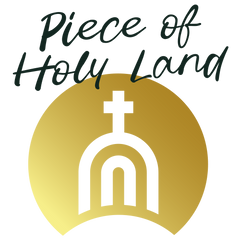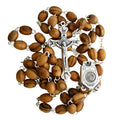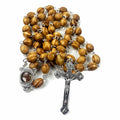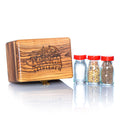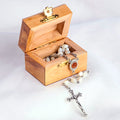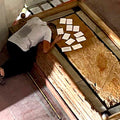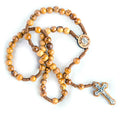Uncovering the Secret History of Prayer Before the Rosary
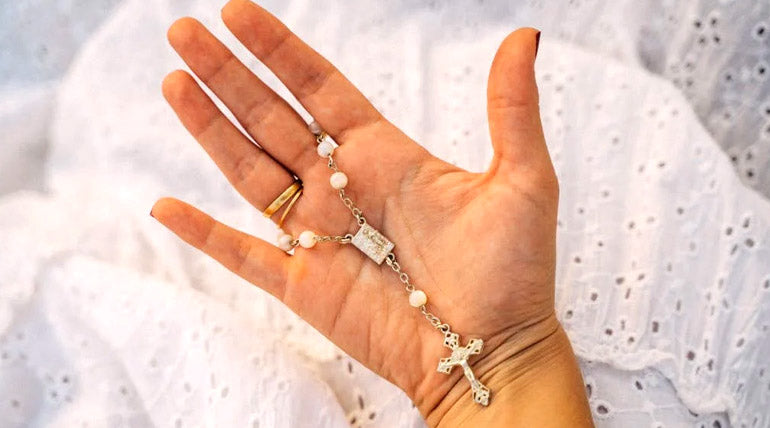
Tracing the Evolution of Christian Prayer Beads and Their Deep Spiritual Roots
The Power of Repetition: Early Prayer Traditions Before the Rosary
The rosaries, as we know it today, is a cornerstone of Catholic devotion, offering a structured way to meditate on Christ’s life and the intercession of the Blessed Virgin Mary. However, its origins stretch back centuries before Saint Dominic popularized it in the 13th century.
Early Christian prayer practices often focused on repetition as a means of spiritual discipline and contemplation. The Psalms, widely recited by Jewish communities, were also integral to early Christian worship. Many believers would repeat the Lord’s Prayer (Paternoster) multiple times a day as a structured form of devotion, laying the foundation for prayer beads as a counting aid. Repetitive prayers helped the faithful maintain focus, resist distractions, and develop a rhythm of meditation that continues today.
The Paternoster Beads: A Precursor to the Rosary
One of the earliest Christian prayer bead traditions involved Paternoster beads, which were used by monks and laypeople alike to track their recitation of the Lord’s Prayer. The name "Paternoster" comes from the Latin words for "Our Father," referring to the opening words of the prayer Jesus taught His disciples.
During the Middle Ages, many Christians sought to emulate the monastic practice of reciting the 150 Psalms of David, a practice that was difficult for those who were illiterate. To make this devotion more accessible, people began reciting 150 repetitions of the Lord’s Prayer, using beads or knots on a rope to keep count. This structured devotion mirrored the later format of the rosary, which eventually evolved into the three sets of 50 Hail Marys known today.
As these traditions spread, Paternoster beads were often worn on belts or around the wrist, serving not only as prayer tools but also as visible symbols of faith. Archaeological evidence has shown variations of these beads among medieval Christian artifacts, indicating their widespread use across Europe.

The Role of Prayer in Christian Monasticism
Monastic communities played a crucial role in preserving and formalizing early Christian prayer traditions. The Rule of Saint Benedict (6th century) emphasized the importance of structured daily prayer, instructing monks to pray at set intervals throughout the day. This practice, known as the Divine Office, included the recitation of psalms, hymns, and prayers at specific hours.
Since monks would often recite 150 psalms a day, counting devices like knotted ropes or beads became essential tools for maintaining the sequence of prayers. This monastic influence shaped the later development of the rosary, which provided lay Christians with a similar structure for daily prayer and meditation.
Jewish Prayer Traditions and the Christian Use of Beads
The use of prayer beads predates Christianity, with Jewish prayer traditions influencing early Christian practices. Observant Jews used tzitzit (knotted fringes on prayer garments) as a tactile reminder of the commandments, and some traditions incorporated stringed knots to aid in repetitive prayer.
This concept of using physical objects to enhance prayer and devotion likely carried over into Christian communities, where beaded prayer ropes helped monks and the faithful maintain focus during lengthy meditations. These early influences contributed to the later structured prayer systems that included the development of the rosary.
The Jewish tradition of repeating scriptural phrases, such as the Shema (“Hear, O Israel: The Lord our God, the Lord is One” - Deuteronomy 6:4), closely parallels the meditative repetition in later Christian prayer traditions, particularly in the rosary.
Saint Dominic and the Rise of the Modern Rosary
The transition from Paternoster beads to the structured Hail Mary-centered rosary is largely attributed to Saint Dominic, a 13th-century Spanish priest and founder of the Dominican Order. According to tradition, Saint Dominic received a vision of the Virgin Mary in which she urged him to spread devotion through the structured prayer of the rosary as a means to combat heresy and encourage deeper meditation on Christ’s life.
This new format incorporated:
-
The Hail Mary prayer, which had been developing in Christian tradition
-
The division of prayers into decades, each focusing on different mysteries of Christ’s life
-
A cycle of meditations on the Joyful, Sorrowful, and Glorious Mysteries
The spread of the rosaries was also aided by the Dominican Order, which actively promoted this devotion as a means of strengthening faith and increasing devotion to Mary. Over time, the rosary became associated with numerous miraculous victories, such as the Battle of Lepanto in 1571, which was attributed to Marian intercession following widespread rosary prayer.

The Evolution of Rosary Practices Through the Centuries
Over the centuries, the rosary underwent further refinement. By the 16th century, Pope Pius V officially established the format that included the 15 decades of Hail Marys, divided into three sets of mysteries. Later, Pope John Paul II expanded this with the addition of the Luminous Mysteries in 2002, reflecting on Christ’s public ministry.
Different cultures have also contributed unique rosary traditions. For example:
-
In Eastern Europe, some Orthodox Christians adopted prayer ropes, known as chotki or komboskini, which consist of 33, 50, or 100 knots, each representing a prayer. These ropes are primarily used to recite the Jesus Prayer ('Lord Jesus Christ, Son of God, have mercy on me, a sinner'), a repetitive devotion akin to the structure of the rosary.

-
In Latin America, special Marian devotions like the Rosary of the Seven Sorrows emerged, emphasizing deep contemplation on the suffering of Mary during Christ’s Passion. These devotions often involve processions, recitations of the Seven Sorrows, and the use of unique seven-decade rosaries designed specifically for this form of prayer.

-
In the Philippines, elaborate processions involving the rosary became central to religious celebrations, particularly during the Flores de Mayo and Santacruzan festivals. These events honor the Virgin Mary with vibrant street parades, floral offerings, and communal rosary recitations. Devotees carry intricately designed rosaries and religious icons while singing hymns, symbolizing their deep Marian devotion.
These variations demonstrate how the rosary has remained adaptable while retaining its essential meditative purpose.
Luxury Handmade Rosaries: A Connection to Tradition
Today, many faithful continue to pray the rosary not only as an act of devotion but also as a way to stay connected to centuries of Christian tradition. Handmade rosaries, particularly those crafted from Holy Land materials, carry a special significance, linking the faithful to the sacred history of Christianity.
Among the most cherished devotional items are:
-
Immaculate Heart Rhinestone Rosaries – This stunning rosary is designed to honor the Immaculate Heart of Mary. Featuring delicate rhinestones, a heart-shaped center, and a beautifully detailed crucifix, it serves as a symbol of unwavering faith and devotion.
-
Olive Wood Rosary with Holy Water – Sustainably crafted from the very trees that have stood in the biblical landscapes for centuries, infused with sacred water from the Holy Land.
-
Mother of Pearl Rosary with Holy Soil – A beautifully handcrafted rosary made from luminous mother of pearl, infused with sacred soil from the Holy Land, offering a deep spiritual connection to faith.
-
Pearl and Gemstone Rosaries – Elegant and timeless, these rosaries are crafted from natural pearls and gemstones, adding a luxurious touch to prayer and meditation.
Final Thoughts: The Everlasting Power of Prayer
From the early Paternoster beads to the fully developed rosary, Christian prayer traditions have evolved while maintaining a core focus on deep, repetitive meditation. This enduring practice connects believers to the past, providing a structured way to grow in faith and devotion.
For those seeking a meaningful connection to history, luxury handmade rosaries crafted from the Holy Land materials serve as both spiritual tools and cherished heirlooms. Explore our collection and continue the tradition of prayer that has shaped Christianity for centuries.
SHARE:

